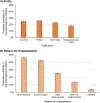Initiation of oral anticoagulation in US older adults newly diagnosed with atrial fibrillation during hospitalization
- PMID: 37092856
- PMCID: PMC10523931
- DOI: 10.1111/jgs.18375
Initiation of oral anticoagulation in US older adults newly diagnosed with atrial fibrillation during hospitalization
Abstract
Background: Atrial fibrillation is a common cause of stroke among older adults and is often first detected during hospitalization, given frequent use of cardiac telemetry.
Methods: In a 20% national sample of Medicare fee-for-service beneficiaries, we identified patients aged 65-or-older newly diagnosed with atrial fibrillation while hospitalized in 2016. Our primary outcome was an oral anticoagulant claim within 7-days of discharge. Multivariable logistic regression analyses assessed relationships between anticoagulation initiation and thromboembolic and bleeding risk scores while controlling for demographics, frailty, comorbidities, and hospitalization characteristics.
Results: Among 38,379 older adults newly diagnosed with atrial fibrillation while hospitalized (mean age 78.2 [SD 8.4]; 51.8% female; 83.3% white), 36,633 (95.4%) had an indication for anticoagulation and 24.6% (9011) of those initiated an oral anticoagulant following discharge. Higher CHA2 DS2 -VASc score was associated with a small increase in oral anticoagulant initiation (predicted probability 20.5% [95% CI, 18.7%-22.3%] for scores <2 and 24.9% [CI, 24.4%-25.4%] for ≥4). Elevated HAS-BLED score was associated with a small decrease in probability of anticoagulant initiation (25.4% [CI, 24.4%-26.4%] for score <2 and 23.1% [CI, 22.5%-23.8%] for ≥3). Frailty was associated with decreased likelihood of oral anticoagulant initiation (24.7% [CI, 23.2%-26.2%] for non-frail and 18.1% [CI, 16.6%-19.6%] for moderately-severely frail). Anticoagulant initiation varied by primary reason for hospitalization, with predicted probability highest among patients with a primary diagnosis of atrial fibrillation (46.1% [CI, 45.0%-47.3%]) and lowest among those with non-cardiovascular conditions (13.8% [CI, 13.3%-14.3%]) and bleeds (3.6% [CI, 2.4%-4.8%]).
Conclusions: Oral anticoagulant initiation is uncommon among older adults newly diagnosed with atrial fibrillation during hospitalization, even among patients hospitalized primarily for atrial fibrillation and patients with high thromboembolic risk. Clinicians should discuss risks and benefits of oral anticoagulants with all inpatients found to have atrial fibrillation.
Keywords: anticoagulation; atrial fibrillation; frailty; geriatric cardiology; inpatient.
© 2023 The American Geriatrics Society.
Conflict of interest statement
Dr. Anderson reports research grants from the American Heart Association, American College of Cardiology, Boston OAIC Pepper Center, and US Deprescribing Research Network outside of the submitted work and honoraria from Alosa Health. No other disclosures were reported.
Figures



Similar articles
-
Trends in Use of Oral Anticoagulants in Older Adults With Newly Diagnosed Atrial Fibrillation, 2010-2020.JAMA Netw Open. 2022 Nov 1;5(11):e2242964. doi: 10.1001/jamanetworkopen.2022.42964. JAMA Netw Open. 2022. PMID: 36399339 Free PMC article.
-
The Effect of Bleeding Risk and Frailty Status on Anticoagulation Patterns in Octogenarians With Atrial Fibrillation: The FRAIL-AF Study.Can J Cardiol. 2016 Feb;32(2):169-76. doi: 10.1016/j.cjca.2015.05.012. Epub 2015 May 27. Can J Cardiol. 2016. PMID: 26277091
-
Geriatric Elements and Oral Anticoagulant Prescribing in Older Atrial Fibrillation Patients: SAGE-AF.J Am Geriatr Soc. 2020 Jan;68(1):147-154. doi: 10.1111/jgs.16178. Epub 2019 Oct 1. J Am Geriatr Soc. 2020. PMID: 31574165 Free PMC article.
-
Oral anticoagulation after catheter ablation of atrial fibrillation and the associated risk of thromboembolic events and intracranial hemorrhage: A systematic review and meta-analysis.J Cardiovasc Electrophysiol. 2019 Aug;30(8):1250-1257. doi: 10.1111/jce.14052. Epub 2019 Jul 18. J Cardiovasc Electrophysiol. 2019. PMID: 31257677
-
Balancing bleeding and thrombotic risk with new oral anticoagulants in patients with atrial fibrillation.Expert Rev Cardiovasc Ther. 2013 Dec;11(12):1619-29. doi: 10.1586/14779072.2013.839214. Expert Rev Cardiovasc Ther. 2013. PMID: 24215192 Review.
Cited by
-
Assessment and Management of Atrial Fibrillation in Older Adults with Frailty.Geriatrics (Basel). 2024 Apr 15;9(2):50. doi: 10.3390/geriatrics9020050. Geriatrics (Basel). 2024. PMID: 38667517 Free PMC article. Review.
-
Frailty and Cardiovascular Health.J Am Heart Assoc. 2024 Aug 6;13(15):e031736. doi: 10.1161/JAHA.123.031736. Epub 2024 Jul 26. J Am Heart Assoc. 2024. PMID: 39056350 Free PMC article. Review.
-
Management of Atrial Fibrillation in Elderly Patients: A Whole New Ballgame?J Clin Med. 2025 Mar 28;14(7):2328. doi: 10.3390/jcm14072328. J Clin Med. 2025. PMID: 40217779 Free PMC article. Review.
References
-
- January CT, Wann LS, Calkins H, et al. 2019 AHA/ACC/HRS Focused Update of the 2014 AHA/ACC/HRS Guideline for the Management of Patients With Atrial Fibrillation: A Report of the American College of Cardiology/American Heart Association Task Force on Clinical Practice Guidelines and the Heart Rhythm Society in Collaboration With the Society of Thoracic Surgeons. Circulation. 2019;140(2). doi:10.1161/CIR.0000000000000665 - DOI - PubMed
-
- Essien UR, Magnani JW, Chen N, Gellad WF, Fine MJ, Hernandez I. Race/Ethnicity and Sex-Related Differences in Direct Oral Anticoagulant Initiation in Newly Diagnosed Atrial Fibrillation: A Retrospective Study of Medicare Data. Journal of the National Medical Association. 2020;112(1):103–108. doi:10.1016/j.jnma.2019.10.003 - DOI - PMC - PubMed
Publication types
MeSH terms
Substances
Grants and funding
LinkOut - more resources
Full Text Sources
Medical

